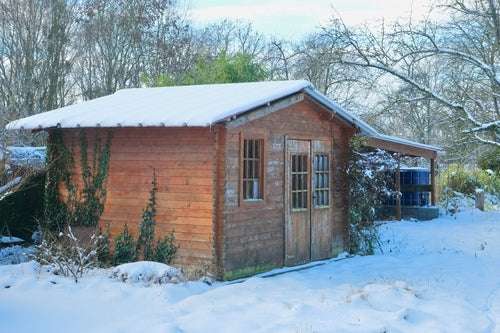
7 Ways to Protect Your Shed During the Winter
Winter calls for some extra TLC when it comes to your shed.
As the temperature plummets, rainfall increases, and the ground becomes icy, it's important to keep your shed in great condition so you won't have to splash the cash on a replacement.
If you use your shed frequently, even during the winter, then this guide will help you keep it warm and functional so you can snuggle up in your 'she shed' or 'man cave' and shut out the rest of the world for a while.
1. Inspect and Repair the Roof
Whether you have a storage shed for furniture or use it as an entertainment space, no one wants rain to soak up their belongings!
The roof of your shed can become damaged over time, especially if it's not regularly maintained. The roofing felt can accumulate holes, leading to leaks, so you'll want to replace it if necessary.
To do so, remove the old felt and fascia boards and add new felt to your shed. For a step-by-step guide, read our guide on how to replace a shed roof.
2. Seal Gaps and Cracks
If your shed has worn down over the years and produced gaps and cracks, you'll want to seal them to prevent leaks, drafts, and pests in the winter.
Start by examining areas around entrances, such as doors and windows, and places where two different materials meet. Use a waterproof sealant to fill in any gaps or replace weatherstripping around window frames.
If you notice any cracks or weak spots in the roof, seal them with roofing caulk or bitumen tape. Door stoppers are also a great way to prevent drafts and rainwater from seeping through.
3. Apply Wood Treatment
With winter comes a higher risk of damp and mould growth due to wetter weather conditions.
That's where wood treatment comes in. It not only provides an extra layer of protection against rot and dampness but also enhances the appearance of your shed, creating a glossy, pigmented appearance.
Wood preservatives can also protect against UV damage, preventing fading, and waterproof against rain and snow. Focus on doors, windows, and the roof. But don't neglect the interior of your shed! Applying treatment to walls and floors can guard against internal damage.
4. Improve Ventilation
Efficient ventilation is necessary for every shed throughout the year, not just in winter.
Add an extractor fan or ventilation grilles to your shed to allow for clean air to flow through. This will prevent bad odours, condensation, and dampness from settling (because who wants a smelly shed?).
If you've struggled with pest infestations in the past, opt for louvred vents, which keep rain and pests from entering. Don't overcrowd your shed to avoid high moisture levels, and install a small, portable dehumidifier to reduce mould and mildew.
5. Insulate the Shed
Insulation is an important factor whether you use your shed to store tools or as a workshop or office space.
PIR insulation boards and foil-backed insulation boards are easy to install and highly effective at keeping heat in. This is ideal for people who frequently use their sheds for work or hobbies.
Insulate the walls, floors, and ceilings and lay a damp-proof membrane (DPM) on the floor to prevent moisture absorption. For more information, follow our guide on how to insulate a shed.
6. Maintain Surrounding Area
Keeping the area around your shed maintained is just as important as keeping your shed in good condition.
To do this, remove overhanging branches from above your tree that could fall and damage the roof. If you have overgrowing plants, shrubs, and vines around your shed, cut and trim them to keep the base of the shed dry and pests at bay. It's also best to throw away any piles of rubbish or old furniture for this reason.
During the winter, snow can accumulate around your shed, melting and leading to excess moisture. To prevent this, rake away any snow and shovel it away from the perimeter to stop water seeping through.
7. Check and Maintain Gutters
Guttering on your shed plays a large role in preventing water pooling and reducing the risk of leaks and structural damage.
During winter, clear away twigs and debris from your sheds' guttering to prevent water flow from being blocked. Inspect your gutters for any small cracks and holes and seal them with waterproof gutter sealant.
The downspouts should also be free from blockages, so use a plumber's snake or hose to remove anything blocking the pipes. You can also install gutter guards, such as mesh screens and foam inserts, to stop leaves and larger debris from getting in.
Choose Atlas Sheds for Durable Garden Sheds
Are you looking to upgrade your garden? If so, Atlas Sheds provides a range of durable, weather-resistant garden sheds designed to withstand the harshest weather conditions.
From garden offices to tool sheds, explore our collection to find the perfect shed to protect your tools, equipment, and outdoor belongings this winter.